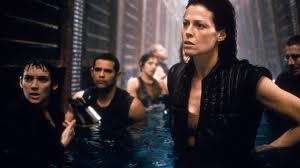It seems only right that my last Countdown was delayed until after Prometheus was released. I suspect the aftertaste would have hindered my anticipation or perhaps have given the prequel an unfair advantage. Comparing the two most recent Alien films will answer any questions as why 20th Century Fox sought out Ridley Scott’s return.
AVP-R picks up immediately after the conclusion of the first AVP. The corpse of the original hero predator (if you call him that) is being returned to the race’s home planet. On route, an newborn alien–a hybrid of alien and predator–erupts from the corpse, kills off the remaining passengers, and somehow reroutes the ship back to Earth. Was one of the predators gripping a large steering wheel, and in its dying state, tugged the wheel 180 degrees?
The predator world send a lone warrior to obliterate the alien threat and destroy any evidence of the xenomorphs presence. (Would leaving proof of their existence somehow make humans a less appealing prey for future hunts? Why are they concerned about PR?)
Meanwhile, the aliens begin to multiply rapidly. Like the first AVP, there’s no waiting time during the alien gestation cycle. After the facehugger releases its human captive, they regain consciousness and the infant explodes from their chests. AVP-R must hold the record for the number of disgusting alien chest-burstings. Seconds later, fully grown aliens are in kill-mode
AVP-R pushes into the Friday the 13th philosophy of horror. A dozen cardboard characters are introduced–many of which will be slaughtered. There’s not one interesting human face in the bunch. Even the cute child is devoid of any sympathy. And like most of these films, when one character is killed, there is little remorse or sense of loss–just blood and guts.
Unlike the first AVP, the annoying humans are completely disengaged from the main plot. A good chunk of the film follows each character through a series of Dawson’s Creek obstacles. What’s the point? They’re as good as dead–and I’m fine with that.
The other half of AVP-R follows the lone Predator’s hunt for increasing horde of Aliens, who are preoccupied rotating between destroying skulls or capturing them to carry alien fetuses. At this point, I believe the audience deserves an explanation on the alien host selection process. Do the xenomorphs have mood swings?
In the brief 90-minute running time, there is not one single moment that’s original. At this stage, I’ve witnessed enough demolished chests and skulls. The Predator uses a familiar bags of tricks. There is no mystery; the predator even takes his mask off early in the feature to show its usual Stan Winston design–remaining the same ugly mother fucker who appalled Arnold Schwarzenegger and Danny Glover. Yet the predator has a dramatic unmasking in the finale. Why? We know what it looks like. Are the Predator fans that nostalgic? Apparently so. The film-makers re-construct sounds and visual cues from all seven Predator and Alien features. Even the sparse unique qualities of the first AVP have been reused.
 The Alien leader and “son” of the dead predator–the Predalien–is nothing more than a steroid-induced version of the xenomorph with an ability to impregnate humans directly (and disgustingly) rather than lay eggs. Is this some hint at the predator’s own breeding capabilities?
The Alien leader and “son” of the dead predator–the Predalien–is nothing more than a steroid-induced version of the xenomorph with an ability to impregnate humans directly (and disgustingly) rather than lay eggs. Is this some hint at the predator’s own breeding capabilities?
Most bizarre is that the film takes place in a small community in Colorado. Although the first AVP took place on Earth, the setting was reserved to the tight, dark corridors of a buried temple. AVP-R had an opportunity to unleash the monsters in a surrounding that did not involve dark, claustrophobic quarters. Yet, all of the monster scenes occur in long, dark corridors.
I hated this movie. Despite the faults of the latter Alien prequels, none have given me the displeasure as AVP-2. There’s no singular element that’s worth praising. Even the technical capabilities are hindered by the overly dim lighting that negates any of the details in the special effects and visual qualities. The fast editing disallows any comprehension of the action to say nothing of leaving anything to our imaginations. There is not one glimmer of suspense or terror. At not one moment did I care about anything that transpired–I just sat patiently waiting for the pain to stop.
AVP-2 was rated R for returning the disgusting factor that was omitted from from the first AVP, which was rated PG-13 rating. The film, however, won’t even appeal to gore-hounds who love seeing heads explode. The editing is too fast and the light is too dark to appreciate any of the bloody recesses. The film is called subtitled “Requiem”, meaning funeral, for no reason other than to highlight the letter ‘R’ as a sign that the franchise has return to its depraved roots. How about we just call the damn thing “Alien vs. Predator: The Return”! “Requiem” is a term used for a Fox Searchlight Picture. Perhaps the film-makers pontificated the end. The “Requiem” was a final trumpet call for a franchise that would end with fans mourning the depreciation of once great–and respectable–franchise.
Final Thoughts…
The Alien franchise has endured for over thirty years mainly due to its two initial features and the iconic imagery of the many monsters the films introduced. Although the saga has had more downs than ups–including the disappointing Prometheus–the saga continues to captivate hearts and minds based on the brilliant storytelling of the Ridley Scott and James Cameron. The first two films are classics in their respectable genres.
Despite the numerous flaws I’ve found with the latter installments, each film has been entrusted to different film-makers, some notable, others no-so-much. The series has unfortunately chased the formula of the first and second films too often, but each film–even the AVPs–were bestowed their own vision. Even in face of failure, many of the writers, directors and stars were given opportunities to reach great heights. Each Alien film also represented a certain period in the history of cinema as the average period between features was five years.
Despite the technological barriers from 1979 and 1986, Alien and Aliens remain the saga highlights due to their reliance of the audiences’ imaginations. Even with Prometheus, this philosophy has not been practiced since.
The aliens themselves remain a scary, iconic image whose imprint on medium is undeniable. Regardless of where the saga heads after the smoke of Prometheus clears, the saga will continue and I will remain longing for another great scare.













